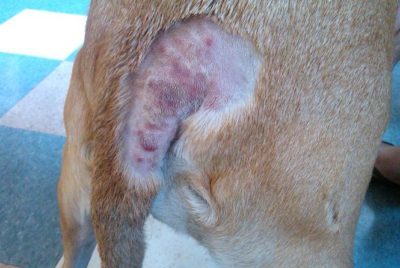Hot Spots in Dogs: What are they and how are they treated?

Hot Spots in Dogs: What are they and how are they treated?
Hot spots are a common source of confusion among dog owners. While I was clipping and cleaning the hot spot in the photograph, the owner asked, “What is that?”
Medically Speaking
A hot spot is technically acute, moist dermatitis. Acute means the hot spot occurs quickly. Moist means the skin oozes fluid. Dermatitis is inflammation of the skin. Despite how nasty hot spot look, not all are infected.
The Hot
Just looking at a photo of a hot spot you can see it looks hot, and if you were to put your hand on the affected area, it would feel hot as the result of the inflammation in skin. Inflammation also causes the skin to be red. The skin is raw because the dog has been licking at it. In a long-haired dog, hot spots can hide under the fur, but the wet, slobbery patch of hair is a giveaway to the underlying abnormality.
The Spot
Hot spots are localized abnormal areas on the skin. If the abnormality involves most or all of the skin, then the problem is not a hot spot. Hot spots can be really painful. Sometimes a dog will cry and try to bite when someone tries to examine the spot.
The Diagnosis
Hot spots have several different causes. Allergies are the most common. For dogs with a hot spot near the tail, the diagnosis is likely fleas, as fleas tend to live near the tail base. If the dog is allergic to fleas, the bites set off the itch-scratch cycle resulting in a hot spot. Environmental allergies, such as those to pollen, dust and mold cause similar itching and scratching that triggers a hot spot. Ear infections, matted hair and razor burn can also lead to hot spots.
The Treatment
Most hot spots will heal naturally if the fur is clipped and cleaned AND the dog is prevented from licking the skin. T-shirts, cones and donut collars can be used to prevent dogs from further traumatizing the red, raw skin. Serious hot spots may need antibiotics for successful treatment. If allergies are the underlying cause of the hot spot, treatment for allergies may also be necessary. If you notice your dog licking one particular spot of skin, check carefully under the fur and make sure there is not a hot spot developing.






























